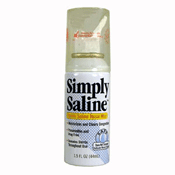Care of the Nose
To Pamper Your Nose and Avoid Nosebleeding . . . . . . . .
MOISTEN, SOFTEN, AND CLEANSE THE FRONT PORTION OF THE NOSE.
Apply saline spray (Simply Saline™ aerosol preferred) at least twice a day morning and night. Childen in daycare and preschool should have the saline spray 3 times a day including morning, immediately after they return from the center, and at night. Morning and night, follow the saline with the application of over-the-counter antibiotic ointment, Neosporin™ or generic triple antibiotic ointment, on a cotton applicator such as a Q-tip™ to the inside of the nostril and the front part of the nasal septum, the wall which divides one side of the nose from the other. This saline-antibiotic mix softens the linings and any crusts on them and eliminates the local infections which drive crusting and nosebleeding.



KEEP THE NASAL LININGS MOIST AND CLEAN.
Have your child breathe humidified air! Use a warm mist type humidifier and maintain the relative humidity at 40-45%. See the information page about humidifiers for more information.
DO NOT BLOW THE NOSE!
It irritates nasal linings by stripping the mucous protective layer off them, elevates the pressure within veins producing bleeding, and forces infected material up into the sinuses and ears. To keep the nose clear, use saline mist nasal irrigation and either topical decongestants (Little Noses Decongestant Drops for babies, mild Neo-Synephrine nasal spray for children 2 to 6 years of age, and Afrin for those 6 years and older) or the systemic decongestant Sudafed™ or the generic equivalent. Gently wipe away mucus. If the nose had been meant to be blown with mucus coming out the front of it, kids would be born with gutters and downspouts in front.
DO NOT PICK THE NOSE OR INSERT ANYTHING INTO IT.
The lining of the nose is very delicate with a network of blood vessels located very close to the surface. Factors which irritate the linings will lead directly to bleeding or lead to production of mucus which can then dry and injure the linings. If your child picks the nose at night without knowing it, use a small Band-Aid™ to cover the nostril.
AVOID SNEEZING THROUGH YOUR NOSE.
Sneezing, like nose blowing, strips the mucous coating and elevates the blood pressure. Suggest that your child sneeze through the mouth.



To Treat Nosebleeding . . . . . . . .
Have your child sit up. Use what I call the 2-SPRAY-5 plan.
Stop nosebleeding, which most often comes from the very front of the nose, by pinching the nostrils against the middle wall of the nose, the septum. Begin with a 2 minute initial pinch. It will take that long for bleeding to initally slow and stop, BE PATIENT! Then quickly spray in mild Neosynephrine™ for children under 6 years or Afrin decongestant nose spray for those over 6 years. The decongestant spray will cause the broken blood vessels to go into spasm and help halt the bleeding. After spraying, then reapply pressure for another 5 minutes by the close. BE PATIENT!
For persisting nosebleeding, apply Nosebleed QR, a hydrophilic polymer, which absorbs moisture from the site of the nosebleed and generates an instant protective scab that effectively stops the bleeding and oozing. The active ingredient is a powder, delivered to the nasal linings on a Q-tip-like applicator. This product is available in stores and online at www.drugstore.com.

